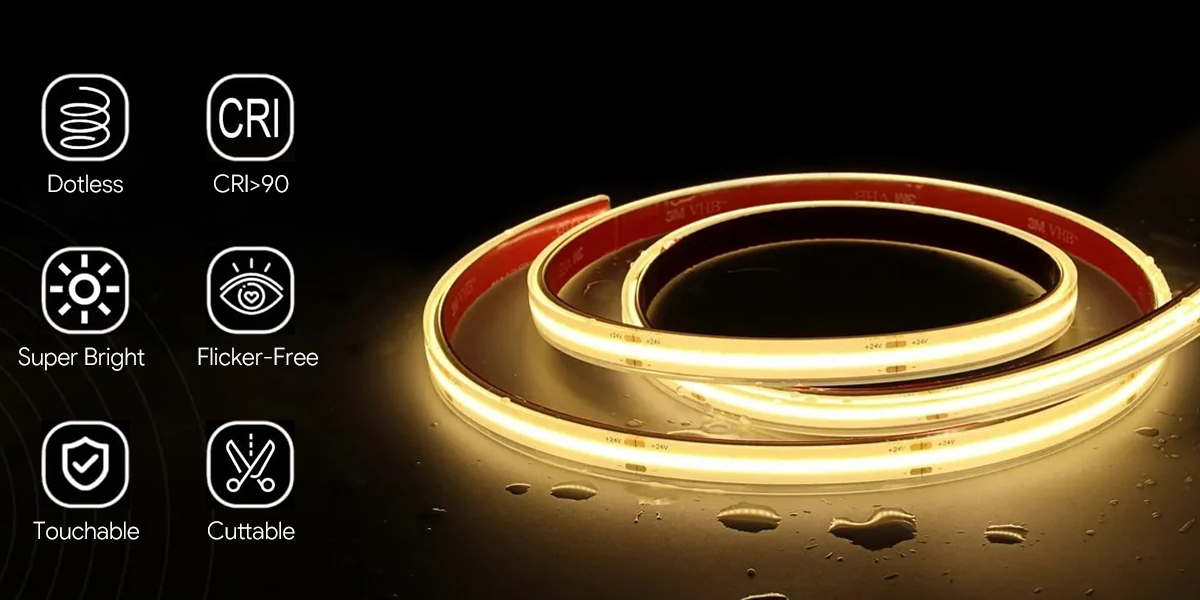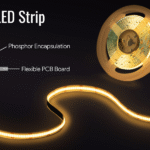In today’s LED lighting industry, people are seeking softer, more uniform, and more efficient lighting solutions. Imagine light flowing smoothly and seamlessly, illuminating your space without a single shadow or light spot.
COB LED strip represent a high-density linear lighting solution engineered for projects demanding smooth, uninterrupted illumination. They eliminate visible light spots, even in shallow channels or exposed installations. Within just a few years, COB technology has rapidly become the new benchmark for professional-grade LED strip lighting.
Next, we’ll explore the essence and future of COB LED strips and why they’ve become the preferred choice for countless users.
What Is COB LED Strip?
COB, also known as Chip-On-Board, is a chip packaging technology. COB LED strips attach many LED chips directly onto a flexible base and then cover them with a layer of phosphorescent silicone to create a smooth, even light strip.
Unlike standard LED strips that display individual light points, COB strips achieve higher LED density in a smaller space, delivering brighter and more efficient illumination. This high-density layout eliminates visible light spots, providing continuous light even in shallow profiles or exposed installations.
In summary, COB LED strips are flexible lighting solutions utilizing chip-on-board technology to deliver seamless, uniform illumination with enhanced efficiency and no visible LED hotspots.
COB LED Strip Lights vs. SMD LED Strip Lights

When comparing COB (Chip-On-Board) LED strip lights to traditional SMD (Surface Mount Device) LED strip lights, multiple factors must be considered. Both technologies have distinct advantages and disadvantages, depending on the specific requirements of your lighting project.
Light Output
COB LED strips deliver continuous, uniform illumination, whereas SMD LED strips consist of visible light points, resulting in uneven lighting. Consequently, COB strips are ideal for applications requiring minimal shadowing.
Brightness
COB LEDs mount multiple LED chips directly onto the circuit board, whereas SMD LEDs feature only one chip. Consequently, COB strips are typically brighter than SMD strips. SMD LED brightness varies by strip type—for example, SMD5050 is brighter than SMD3528.
Luminous Efficiency
Due to their higher chip density, COB LED strips generally achieve a higher lumens-per-watt output. This translates to brighter illumination and superior lighting performance while consuming less power.
Color Selection
Both COB LED strips and SMD LED strips offer a wide range of color options, including RGB, RGBW, and RGBCCT. However, SMD LED strips hold an advantage for more complex dynamic color transitions and custom lighting effects.
Dynamic Control
COB LED strips offer minimal customization options for individual LED control, whereas SMD strips typically enable this in RGB/RGBW configurations. SMD strips allow control over single LEDs or LED groups, making them suitable for applications requiring dynamic or programmable lighting effects.
Price
Due to differences in packaging and manufacturing processes, COB strips are priced slightly higher than SMD strips. This is because COB LED strips feature higher packaging density, requiring more materials and more complex manufacturing techniques. Consequently, COB LED strips are typically 20% to 30% more expensive than SMD LED strips.
Key Advantages of COB LED Strip

1. Dotless Uniform Illumination
The greatest advantage of COB LED strips lies in their spot-free illumination. Typically featuring up to 480 LEDs per meter (or more), COB strips deliver unmatched brightness and uniformity. This high density ensures no dark spots or visible individual LEDs appear along the strip, making COB strips particularly suitable for visible installations such as under cabinets, mirror edges, or decorative trim.
2. High Color Rendering Index (CRI>90)
COB LED strips typically feature a high Color Rendering Index, reproducing colors more naturally and vividly. In commercial and retail environments, this significantly enhances product display quality and visual comfort.
3. Extended Lifespan
By dispersing heat across a larger surface area, lower operating temperatures reduce stress on the LEDs. When used correctly, COB strips can achieve a lifespan of up to 50,000 hours. Compared to traditional SMD types, they offer longer durability and more stable performance.
4. Wider Beam Angle
COB LED strips offer an 180° beam angle, delivering more uniform illumination and minimizing shadows. This is crucial for spaces requiring visual consistency.
5. Easy Installation
COB LED tape strips are designed for straightforward installation. With their adhesive backing and flexibility, they can be easily affixed to various surfaces—from walls and ceilings to furniture and linear fixtures.
Why COB LED Strip Lights Are Transforming the Lighting Industry
In 2019, industry experts predicted that once LED strip manufacturers completed their technological upgrades, COB technology would become the industry standard. Today, this prediction has become reality.
Between 2021 and 2023, COB LED strips achieved breakthrough progress in high-end applications. As the global lighting market shifted from “price-driven demand” to “quality-driven demand,” COB strips emerged as the preferred choice for retail, healthcare, museums, and premium architectural lighting due to their high color rendering index (≥90), high luminous efficacy (120–130 lm/W), and low SDCM (≤3).
By late 2025 to 2026, COB LED strips will universally achieve luminous efficacy levels of 130–150 lm/W, CRI ≥95, and ultra-low SDCM (≤2), establishing themselves as the global mainstream premium light source.
The lighting industry is evolving toward human-centric, visually comfortable solutions. In applications where light quality and aesthetics are equally important, architects and lighting designers now favor COB technology. It delivers the seamless, high-quality illumination modern spaces demand while offering flexibility and efficiency suitable for any project.
Furthermore, COB strips are compatible with smart lighting systems, supporting adjustable white light, warm light dimming, and RGBW color control. They are suitable for residential, retail, and architectural lighting projects.
COB LED strips are not merely another LED product or technological upgrade. They represent a new phase in seamless, energy-efficient, and flexible lighting design, fundamentally reshaping how modern spaces are illuminated.
Applications of COB LED Strip

COB LED strips are specifically designed for environments demanding exceptional visual consistency. Their uniform, continuous illumination ensures reliable lighting performance even at close range or in exposed settings, making them a dependable solution for precision lighting.
Typical applications include:
- Under-cabinet lighting in kitchens and bathrooms
- Retail display shelves and product racks for merchandise accent lighting
- Architectural accent elements (coves, staircases, moldings)
- Glare-free task lighting for workspaces
- Vehicle and marine lighting in confined spaces requiring high-intensity illumination.
- Signage and commercial installations for premium branding
Installation is straightforward thanks to the self-adhesive 3M backing compliant with TESA 4965 standards; however, professional installation is recommended for complex projects. The light strip can be supplied with a standard 150mm input lead or customized soldered connections tailored to specific application requirements.
Conclusion
The shift from SMD to COB technology represents not merely an upgrade but a complete revolution in LED strip lighting performance. Compared to traditional LED strips, COB strips offer numerous advantages, including high brightness, high energy efficiency, compact structure, and extended lifespan.
COB strips deliver smooth, uniform illumination with enhanced efficiency and durability. Whether lighting a single kitchen cabinet or designing illumination for large commercial spaces, they provide the technology and performance needed to realize your vision.
Thus, COB LED strips are the ideal choice for designers, architects, and homeowners seeking professional-grade lighting results while minimizing time and effort.







